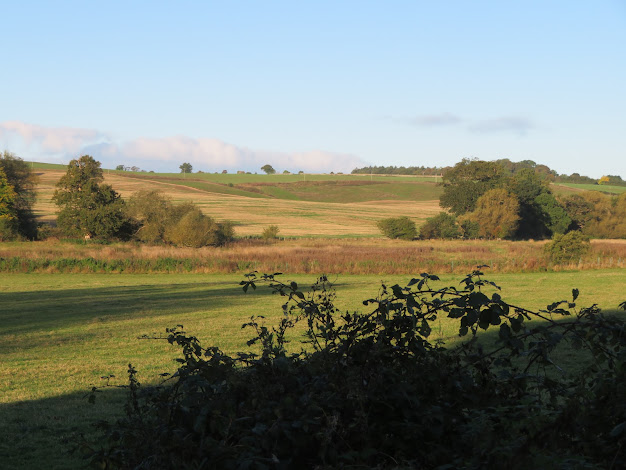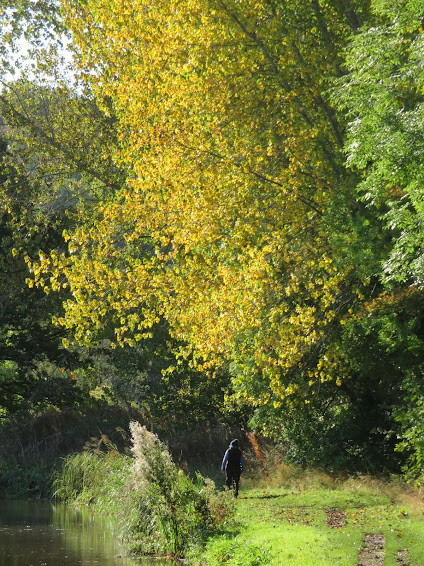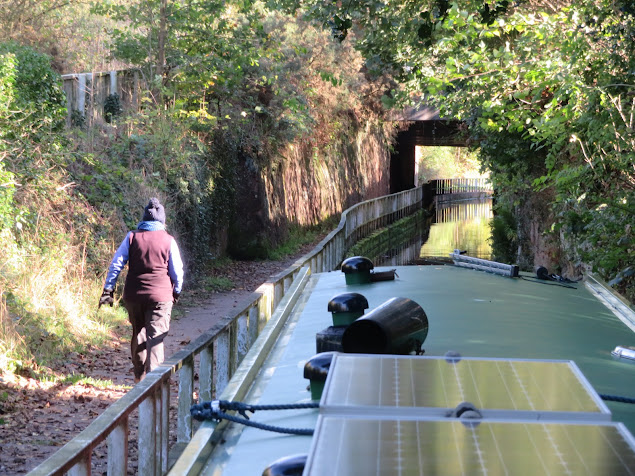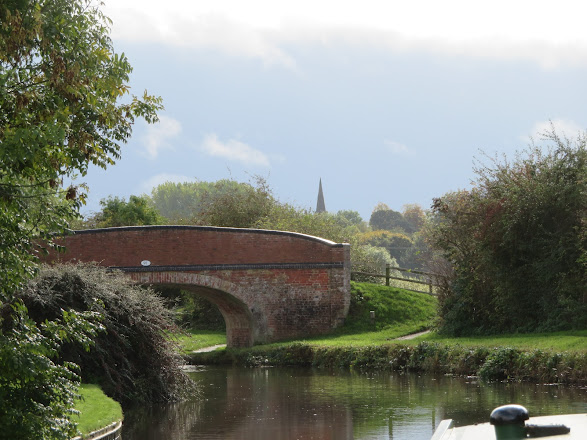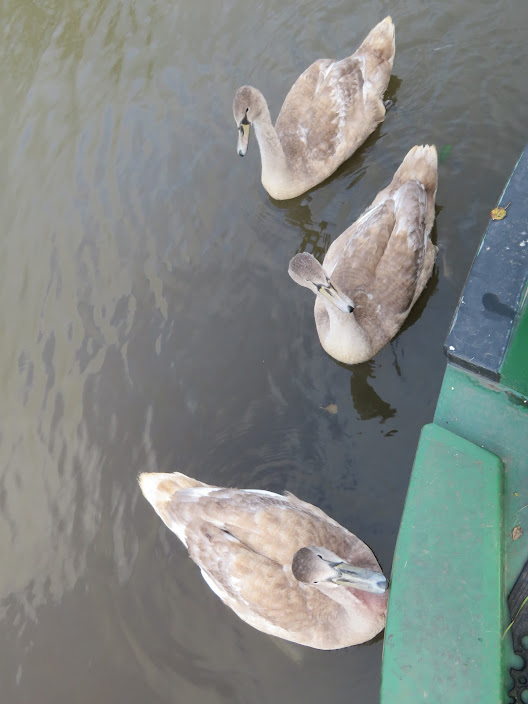We had no rain at all over our stay, but we also had very little sun to brighten it up. However the colours of the beech trees were still something I couldn't stop taking pictures of.
Looking to the south from by the Pavilion along the access road.
Looking from the north towards the Pavilion that is on the right behind the trees in the distance.
Once we got home, and in a rare idle minute I Googled Ingestre Pavilion and checked other sources to see what I could find. If only those that had set up the ghost trail/treasure hunt in the house had known this story maybe they may not have started it!
In the 1840's Ingestre Estate was at its height and part of the estate was the work of maintaining a shoot and deterring poachers, and to do this several gamekeepers were employed. One of these was Walter Morrey. He had been born in Staffordshire in 1816. He married Ann Wright in 1836 at St. Mary's Church in Stafford. Ann was five years older than Walter. Soon after he must have started in the employ of Charles Chetwynd-Talbot, 2nd Earl Talbot of Ingestre as a game keeper. In the 1841 census he is living in Blackheath Cottage. They had seven children 3 girls and four boys, the first being born in 1837 and the last in 1849. By 1840 he was being given a game licence for assured servants by Earl Talbot at the grand cost of £1 7s 6d! It seems that in 1844 he was transferred to the employ of the 3rd Earl as the licence was from Rt. Hon. Earl Talbot and Charles was never an MP, but his son Henry was. Henry inherited in 1849 so again dropped the Rt. Hon. as he went to the Lords.

The Doric arches are original and give the Pavilion its classical splendour, and provide shelter for the doorways. There are three doors at the front, but this one to the right is the front door now.
Walter was joined as a gamekeeper on the estate about 1948 by William Spencer Yarker, who seemed to known as Spencer. He was a couple of years older than Walter and had been born in Westmorland in 1818. He married SusannahThwayte the daughter of a farmer from Reagill Grange, which was a few miles away from Crosby Ravensworth in Cumbria, where they tied the knot in 1843. Two years later they had William Thwaytes Yarker, and then two years after Robert Yarker came along. Both were born over in Westmorland, but the 3rd. son Richard Spencer Yarker was born in Ingestre so it seems that Spencer moved to the Ingestre Estate about 1848. In 1850 living with Spencer and Susannah was Isabella Goule who was Spencer's youngest sister. Spencer and Susannah also had other help in the form of Hannah Rock a 25 year old local girl who was their servant, working in the house. They all lived at Keepers Lodge by the Deer Park and in Waterhen Coppice about 300 yds from any other building and half a mile from the Hall. Earl Talbot thought a lot of Yarker and boosted that since he had arrived the number of deer on the estate had increased as had the health of the herd.

The ceiling of the portico is pretty splendid, and certainly makes the whole experience of staying here quite a bit special.
At the end of February Spencer had a bad turn and it was put down to delirium tremens by Cornelius Waddell the surgeon attached to the Stafford Infirmary, but actually appeared to be a nervous disorder rather than drink related, as everybody agreed he was not addicted to drink. The Doctor told the household to kjeep all dangerous items locked a way and watch him carefully. Over a period of weeks he got back to his normal self and all was well. a couple of months later he was once again struck down and with the same diagnosis, with Dr. Waddell again relating that dangerous items should be kept clear.
Cornelius Waddell was born in Birmingham in 1813. His father William was a victular, wine and spirits business and had owned the Hen and Chickens Hotel on New Street since the early 1800's. This developed in to a major coaching house with around 30 coaches a day passing through in 1819, and a couple of decades later this had increased to 60 a day! He let the pub in 1835 but retained the running of the yard and coaching business that now also had a rental side and a funeral business. He died the next year and the business was bought by his youngest son George. The next eldest son was Cornelius who had married a Maria Churchill Amos from Evesham, whose father was a grocer and hop dealer. They married in 1835 just before Cornelius passed his Apothacarry exams in 1836 in Colchester. They moved straight away and ended up in Stafford where he practiced as a surgeon. He soon became surgeon to the Stafford Victoria Women's Friendly Society and later became surgeon to the Stafford Infirmary.

The window in the last photo is where this one was taken from and symetricaly opposite window can be seen in this one. That one is now in the bathroom. The door below now leads into the downstairs bathroom/shower room. Obviously kept locked. Where this picture was taken from is now a landing at the stop of the stairs that leads to a double and twin bedroom.
Isabella, Spencer's sister, started to look after him, and the next day Walter Morrey another gamekeeper came to help out. The two of them got on very well and Spencer often became edgy if Walter was not there so he never left his side for two weeks, even sleeping in the same room. Isabella was still worried about him at one time and traveled into Stafford to Dr. Waddell. He refused to go and see him but once again advised her to keep everything away from the patient that may harm him. She had been removing all knives and scissors anyway.
Isabella Yarker had been born in Westmorland in 1807 and somehow ended up married to Louis Orlando Goule in Birmingham in May 1829. He was practicing as a surgeon there. His father was Louis Etienne Goule and as the name may suggest the family came from Rouen in France. He died in 1847 having been a surgeon for forty years around Ombersley, north of Worcester. In a previous life he had been in the 17th Light Dragoons, but what a Frenchman was doing fighting for the British is a mystery. Sadly Isabella's husband died in Solihull in 1847 and left her a widow with four children. However she was just visiting to look after her brother at this time.

The central door in this picture leads outside but is kept locked. This is the central sitting room, and the arch to the left leads to the front door/stairwell and another twin room. To the right is the kitchen and the shower room. Of course there is the gallery that connects the two halves of the building on the first floor, making this central room double height for maximum grandeur.
On the fateful day Spencer had woken up and seemed to be in a much brighter mood than of late and suggested that they should go for a walk. This was agreed to as a few days earlier the two had been out shooting rabbits with no ill effects. The double barreled gun, along with the shot and powder had been removed to a cupboard but was not locked. The plan was them to go to the Pavilion which was a ruin at the time, and shoot jackdaws as they roosted in the ruins. To do this in the past Walter Morrey had climbed the staircase to scare the birds and Spencer would shoot them.
About ten minutes later he entered his home through the backdoor directly into the back kitchen. In the room was Hannah Rock, their servant with his youngest child, 17 month old Richard Spencer Yarker on her knee, sat with her back to the door and drinking a cup of tea. Across them room kneading dough on the table by the fire was Isabella. Hannah Rock was a local girl aged 25 and the family still lived in the vicinity of Ingestre Estate. Hannah was in service at an early age and was servant to a family of tailors in Stafford at age 15. Immediately he entered the room he lifted the gun and shot Hannah in the left side of the head. She slumped forward without a noise and died instantly. As the child was falling from her grasp Isabella leapt forward to catch him and this saved her life as Spencer discharged the second barrel at this time and so missed her. She was slightly injured by pellets from either the first or second shot that had ricocheted from the fireplace. After this second shot Spencer turned and ran out of the house into the woods. His wife and two older children were not in the house at the time but Susannah ran up just as he left the backdoor and chased after him. She was heard to shout his name a couple of times and then shriek. At the inquest it was thought that she had come up to him and they had fought but on being overpowered Susannah had passed out. Spencer then reloaded his gun and shot his wife in the chest. He then turned the gun on himself and the second barrel caused terrible damage to the top of his head. He fell forward over his gun.

Looking down from the gallery there is the dining table behind the sofa, french doors lead out to a small sheltered patio and lawn behind the Pavilion and chairs either side of the fireplace. I took some logs along and so had logs fires every night to add to the great charm. We have fires at home and it is always nice for a good atmosphere. Visitors over the years have created a a ghost trail around the house with clues leading you around the room, and the central thing is that the painting above the fire is pretty ghostly as it follows you around the room. You may get the drift. I was not at all interested in the trail, but it was interesting after I got home!!?
After the initial attack in the kitchen Isabella scooped up the child and ran to hide in the poultry shed. The remoteness of the house meant that it was Spencer and Susannah's eldest son, William Thwaytes Yarker, five years old came across his dead mother and father a few minutes later. He continued to the house and found Hannah Rock before running to the Park Lodge to raise the alarm. It was several hours later that Walter Morrey was found a few steps up from the bottom of the stair way with a gunshot wound to his chest. There was no evidence of a struggle. All the bodies were taken to the blood spatted back kitchen. It was two days later when the room had all evidence of the tragedy removed.
At the inquest held the day following the shootings Elizabeth Perkins, wife of Joseph Perkins, the estate woodman who lived at Park Lodge, gave evidence of finding the bodies. She was followed by PC Edward Swindell who found the body of Morrey at the Pavilion. Next came Isabella the eye witness to the killing of Hannah Rock and lastly Cornelius Waddell who gave evidence of Yarker's medical condition. The jury didn't take long to decide that William Spencer Yarker had taken the lives of the three victims whilst labouring under a fit of temporary insanity, and then killed himeslf under the same circumstances. Only three days after the shooting the four bodies were buried at Ingestre Church with over two hundred people in attendance. Walter Morrey's wife was in great distress.

When the Pavilion was built it was erected along the boundary wall of the park at that time, and was placed to look down this ride to lower ground.
I like to conclude a story with a 'what happened then?' section so here goes.
Dr. Cornelius Waddell and his wife Maria Churchill had five children. We appeared in several other high profile Staffordshire court cases as the surgeon of the Infirmary. They died months apart from each other in 1861, in Boulogne. Their estates were not concluded until several years later and they had less than £50 each and they left this to a niece!
Isabella, Spencer Yarker's sister, and survivor of the kitchen shootings, went on to re-marry in 1853, one Philip Dale who was a Master Brazier from Stafford who employed a man and two boys. However he he died in the 1860's In 1871 she is living in Kings Norton with an unmarried daughter. Her son went on to train as a solicitor. By 1881 she is living in Toxteth, Liverpool with another daughter and her husband, along with an unmarried daughter. She dies in Birkenhead in 1885.
Ann, Walter Morrey's widow was left with seven children (Mary, George, James, John, Margaret Emma and Isaac) and no income. We read in the papers that a subscription was started for her. Contributions were made by the Duke of Devonshire, Earl of Harrowby, Earl Dartmouth and George Hudson MP, who became the Railway King. Other monies came from all over the country and well over £30 was collected.In 1851 she was living near Ingestre at a home in Peterson's Cottage with James, Margaret, Emma and Isaac. James age 11 was working on a farm, Margaret was at school and the other two at home. Ann was a game keepers widow with a pension. She got married to William Perkin, a local man, in 1858. He was a widow about 8 years younger than her. He was a labourer. James was living them in 1871 and as a joiner. They had a 12 year old grandson staying with them too. James Cartwright, the grandson is still with hem in 1881 as an unemployed joiner and William at 62 is also unemployed. In 1891 they are still in Hopton village living next door to William's son from the previous marriage but he is now a shopkeeper. Ann dies in 1892.
Mary became a servant at 11 but married John Cartwright, a labourer, nearby in 1858 and went on to have a large family.
George marries in 1881 and became a game keeper for Earl Shrewsbury and lived at Colwich.
James also becomes a game keeper.
John lived with his mother at first and then went as a house servant in 1861 and married Martha in 1865. He worked as a labourer and later a game keeper. On the death of Martha he remarried Ellen.
Margaret was a house servant to a farming family in 1861 and [possibly married one George Wright.
Emma moved in with her mum and William Perkins when they married, and I can find nothing else.
The youngest Isaac also moved in with William and Ann and was still there in 1871 but with the trade of a joiner. Also staying in the house was Jam,es Cartwright William's grandson from his previous marriage. I assume that Isaac took him as an apprentice as ten years later James was also a joiner.
Spencer and Susannah Yarkers children were also horribly left with out a mother or father.
William Thwayte Yarker, born in 1845 had found the bodies and raised the alarm. He was whisked away to Westmorland to live with his aunt Cecilia By 1861 he was a 16 year old student at Green Row Academy a school near Holme Row in the north Lakes that had opened in 1780. It closed in 1871 but at this time there were 26 students between 12 and 20.I can find nothing more of him, but he may have married an Annie Baldwin in Portsmouth. Did he join the Royal Navy?
The middle son Robert Yarker was sent to live at his mother's family home at Reagill Grange with his grandmother and father, along with his younger brother. In 1861 he was a scholar still there, but the farm was now been run by his aunt Ann Thwayte. He must have been a good student as he entered Pembroke College, Cambridge. After this he became an assistant school master at Egypt house at Cowes on the Isle of Wight in 1871. The school was run by Rev. Arthur Watson. He married Edith furlong, a Vicar's daughter in 1874 at Brighton. In 1881 he ia lodging with his wife at OakField Row in Penge, Surrey and as a school master. I can find no death or divorce of Edith, but Robert remarries in 1894 to a lady called Harriette Maria Martin Siequien born in Kingsbridge, Devon. Th service took place in Bath and that is hwhere he seems to remain as in 1901 he is there, still as a school Master and dies there in 1910.
After the youngest, Robert Spencer Yarker, narrowly been killed by his father in the arms of Hannah Rock he was sent with his brother to loive with his grandparents at Reagill Grange, and he was still there in 1861 with his aunt Ann running the place. By 1871 Ann and the household had moved to Hill Top, near Shap. Ann seems to have a pension and living with a niece and two nephews. The niece Margaret Thwayte 26 is down as a domestic servant but Richard at 22 is recorded as an annuitant! The other nephew, Robert Salkeld 18 is a scholar. He sadly died in 1876 at Hill Top for hepatitis and dropsy. The death was witnessed by his cousin Margaret Thwayte.




































